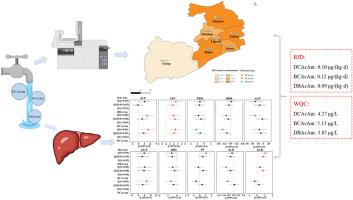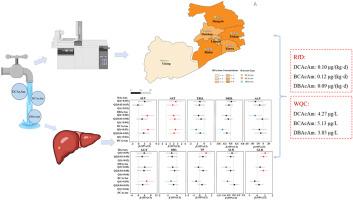基于饮用水暴露与肝功能改变相关性分析的江苏省无锡市某社区人群代表性卤乙酰胺消毒副产物的基准剂量法饮用水水质标准值估算
IF 7.3
2区 环境科学与生态学
Q1 ENVIRONMENTAL SCIENCES
引用次数: 0
摘要
卤代乙酰胺(Haloacetamides, HAcAms)是一种细胞毒性氮消毒副产物,在饮用水中被广泛检测到,但其对健康的影响和水质标准(WQC)尚不清楚。本研究测量了无锡市水中二氯乙酰胺(DCAcAm)、溴氯乙酰胺(BCAcAm)和二溴乙酰胺(DBAcAm)的水平,并分析了它们与829名参与者肝功能的关系。其中,dacam (0.56 ~ 9.83 μg/L)含量最高。对成品水和自来水的综合分析表明,长江水样中3种HAcAms的浓度在旱季高于雨季(p < 0.05)。枯水期和丰水期水库水样中3种HAcAms的浓度均最低(p < 0.05)。广义线性模型显示HAcAms与转氨酶升高之间存在显著的线性相关性(p < 0.05),在排除老年参与者后仍然存在。限制性三次样条(RCS)分析显示,BCAcAm和DBAcAm与白蛋白(ALB)、球蛋白(GLB)和总蛋白(TP)呈显著的非线性相关(p为非线性<;0.05)。采用基准剂量模型,得到DCAcAm、BCAcAm和DBAcAm的参考剂量(rfd)分别为0.10、0.12和0.09 μg/(kg·d), WQC值分别为4.27、5.13和3.85 μg/L。研究结果表明,接触HAcAm可能会损害肝功能,需要进一步的毒理学和流行病学研究。本研究首次估算了HAcAms人群RfD和饮用水WQC,为进一步开展HAcAms人群健康风险评估和制定饮用水相关法规或指南提供依据。本文章由计算机程序翻译,如有差异,请以英文原文为准。


Drinking water quality criteria value estimation for representative haloacetamide disinfection byproducts via a benchmark dose approach based on an association analysis between drinking water exposure and altered liver function in a community population in Wuxi from Jiangsu province
Haloacetamides (HAcAms), a cytotoxic nitrogenous disinfection byproduct, are widely detected in drinking water, but their health impacts and water quality criteria (WQC) remain unclear. This study measured levels of dichloroacetamide (DCAcAm), Bromochloroacetamide (BCAcAm), and dibromoacetamide (DBAcAm) in Wuxi City's water and analyzed their associationwith liver function in 829 participants. DCAcAm (0.56–9.83 μg/L) was the most abundant HAcAms. Comprehensive analysis of finished water and tap water showed that theconcentrations of three HAcAms in the water samples from the Yangtze River were higher in the dry season than in the wet season (p < 0.05). In both the dry season and the wet season, the reservoir water samples had the lowest median concentrations of the three HAcAms (p < 0.05). Generalized linear models showed significant linear correlations between HAcAms and elevated alanine aminotransferase (ALT) (p < 0.05), persisting after excluding older participants. Restricted cubic spline (RCS) analyses showed that BCAcAm and DBAcAm exhibited significant nonlinear correlations with albumin (ALB), globulin (GLB), and total protein (TP) (p for nonlinear<0.05). Using benchmark dose (BMD) modeling, reference doses (RfDs) were derived: 0.10, 0.12, and 0.09 μg/(kg·d) for DCAcAm, BCAcAm, and DBAcAm, respectively, with corresponding WQC values of 4.27, 5.13, and 3.85 μg/L. Findings suggest HAcAm exposure may impair liver function, warranting further toxicological and epidemiological research. This study estimated the population RfD and drinking water WQC of HAcAms for the first time, providing a basis for further HAcAms population health risk assessment and the development of drinking water relevant regulations or guidelines.
求助全文
通过发布文献求助,成功后即可免费获取论文全文。
去求助
来源期刊

Environmental Pollution
环境科学-环境科学
CiteScore
16.00
自引率
6.70%
发文量
2082
审稿时长
2.9 months
期刊介绍:
Environmental Pollution is an international peer-reviewed journal that publishes high-quality research papers and review articles covering all aspects of environmental pollution and its impacts on ecosystems and human health.
Subject areas include, but are not limited to:
• Sources and occurrences of pollutants that are clearly defined and measured in environmental compartments, food and food-related items, and human bodies;
• Interlinks between contaminant exposure and biological, ecological, and human health effects, including those of climate change;
• Contaminants of emerging concerns (including but not limited to antibiotic resistant microorganisms or genes, microplastics/nanoplastics, electronic wastes, light, and noise) and/or their biological, ecological, or human health effects;
• Laboratory and field studies on the remediation/mitigation of environmental pollution via new techniques and with clear links to biological, ecological, or human health effects;
• Modeling of pollution processes, patterns, or trends that is of clear environmental and/or human health interest;
• New techniques that measure and examine environmental occurrences, transport, behavior, and effects of pollutants within the environment or the laboratory, provided that they can be clearly used to address problems within regional or global environmental compartments.
 求助内容:
求助内容: 应助结果提醒方式:
应助结果提醒方式:


